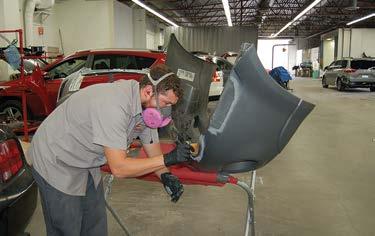
2 minute read
Calculating the ROI in ‘Growing’ Your Own New Body Techs
More collision repair shops are recognizing they’ll never be able to find all the experienced body technicians they will need, and they instead will need to develop one—or more—themselves. So they are hiring an apprentice, and either training them in-house or sending them to training while they work part-time in the shop.

period at the school. The student also finishes the program with a starter tool box and I-CAR credits.
How long will it take the shop to recoup its investment in that student and start generating a return? Let’s work through the math.
Prior to the pandemic, we were seeing the average body technician generating about $53,000 to $63,000 a month in gross sales. That number has risen in the last few years as the average number of parts per job— as well as ADAS-related steps—have increased overall repair costs. And I’ve seen technicians at shops with great estimators, particularly if of health insurance you provide, uniforms, vacation pay, workers’ compensation insurance premiums, etc. But even if you calculate it will take twice that long, 20 weeks, that’s still not a particularly long period for your investment to start providing a return. technicians to OEM or other ongoing training. But if that training improves their productivity or efficiency, the exercise we just walked through can show you the potential return on that investment.
It’s also a good calculation to perform when you think of anything that pulls that technician away from working steadily on vehicles. Every time that technician has to go look for a part or a tool, every time that technician is writing their own supplement notes or having to walk to the office for something, that’s costing your shop the equivalent of $100+ per hour in gross profit. That’s one of the reasons I’m a huge proponent of having an estimator/ repair planner working out in the
It’s that model of schooling coupled with work experience that makes me a huge supporter of the Collision Engineering Program (www. beacollisionengineer.com). Now in place at seven post-secondary schools—and growing—around the country, the Collision Engineering Program puts students through a two-year training regimen in which they rotate eight weeks at school, then eight weeks working within a shop.
I see many of my client shops doing the math and realizing they can receive a good return on their investment in helping a student complete a training program at a school that’s part of the Collision Engineering Program, or at one of the other quality collision repair training programs around the country.
In some cases, these shops are telling these prospective apprentices: If you successfully complete the program, in addition to your other pay and benefits, we’ll pay your monthly student loan payments as long as you’re working within our business.
So how does that pencil out? Obviously, the cost of a student’s training can vary based on the school’s tuition, and on whether the student is attending a local school or needing room and board to attend a program elsewhere. But just for the purpose of this article, let’s say the cost the shop is committing to is $40,000. In this example, that covers two years of tuition and room and board while the student is spending each eight-week account a lot of things, like the cost
Sponsored by:
A few of our Featured Guests:
Mike Anderson
David Leuhr
Brandon Eckenrode
Ryan Evans
Rivian
& many more








